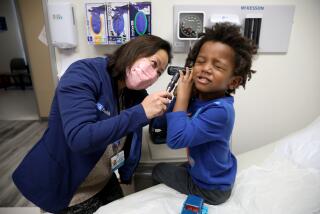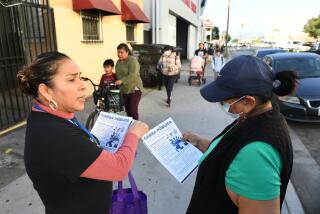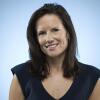Healthcare law also faces plenty of low-tech problems
When advocates for the president’s healthcare law strategized about how to reach the uninsured, they knew exactly whom to tap: mothers who could spread the word about the law’s benefits, sign up their younger children and nudge their twentysomethings to take part.
But beyond the widely publicized problems with the federal website, low-tech challenges also are complicating that part of the drive to sell the program — even in California, where the state website is running more smoothly and officials are fully behind the push.
On a recent evening at Dolores Mission in East L.A., nearly a dozen women who help minister to the poor and sick in their parishes met to discuss the work ahead. With organizing help from a faith-based group known as LA Voice, they had collected hundreds of health surveys from parishioners during Sunday Mass. The results, announced by two of the women, sent a murmur of surprise through the room.
More than a third of adults and nearly a quarter of the children at Dolores Mission said they were uninsured. At St. John the Baptist in Baldwin Park, the surveys showed 51%, or 2,500 adults and children, had no insurance.
The surveys gave the volunteers phone numbers for hundreds of uninsured households. But the volunteers have not yet been trained how to answer questions about insurance. And they cannot sign people up; that responsibility rests with trained enrollment counselors. But only 390 of the state’s 4,165 would-be counselors are certified and ready to assist people — leaving the volunteers scrambling to find enough counselors to sign people up at their November church health fair.
There are other problems: The uninsured can sign up over the phone, but most seem to prefer looking at their options and discussing them before making it official. That leaves the website, which is largely working in California, except that for these potential clients, there are not enough laptops available to help explore their options. For some it’s more basic than that.
“People aren’t going to sign up online by themselves,” said the Rev. Samuel Pullen of LA Voice, who brought the women together. Many of the volunteers who gathered at Dolores Mission, he notes, are not Web savvy. “You need an email to sign up. What if you don’t have an email?” he said.
Much attention has focused on the high-tech problems of the initial enrollment phase for Obamacare. (Because of website issues, White House officials last week extended the deadline for signups to March 31.) Less notice has been given to proponents’ use of the Web to organize their efforts to find those who would benefit from the program.
Through Facebook and social media, groups like MomsRising have recruited 3,000 women nationwide to join their “wellness wonder teams,” offering training through webinars and help for women who want to set up blogs to tell their stories.
Enroll America, a nonprofit organization formed in 2010 to support the enrollment push, is supplementing its field program with a $5-million digital campaign targeting minority women. It will use data analytics, similar to those the Obama reelection campaign used to spectacular effect in 2012, to find women online who are likely to be uninsured and capture their attention through ads on websites they visit.
“Based on the information that we have on users and that we collect as they are searching and going about their day online, we can meet them where they are with our message,” said Anne Filipic, a 2008 Obama campaign alum who later worked in the White House as deputy director at the office of public engagement. “And when they come to our website [at Enroll America], we can actually tailor our website so it shares specific content, or even specific pictures, based on the demographic.”
Filipic’s group, along with Organizing for America — the nonprofit advocacy group formed by President Obama’s advisors after the 2012 campaign — plan a major push before Thanksgiving to encourage women to talk to their adult children during the holidays about signing up for insurance.
Ruth Jaeger, 62, a mother and psychotherapist, is working with other women in her Organizing for America chapter in Marin County to set up a phone bank in November to call women who might be affected by the new law. Earlier this year, her chapter passed out information from a table at farmer’s market.
“Marin County is really a high wealth area and we think everyone’s got insurance, right? Well that’s not true,” Jaeger said. “In this whole process over the past year, it has not ceased to amaze me the number of people who are uninsured.”
In Los Angeles County, the sheer numbers are daunting, and the insurance difficulties complex. Visiting with the women volunteering at Dolores Mission, Amy Luftig Viste, who directs community partner programs at the county health department, tells them that by 2019, there will be 1.3 million uninsured people in the county.
“900,000 of those 1.3 million could get insurance but don’t know it,” Viste said. “I cannot reach 1.3 million people, so I need groups like yours to be putting the word out.”
As he guides his group of female volunteers at Dolores Mission, St. John the Baptist and Blessed Sacrament of Hollywood, Pullen is encouraging them to go slowly as they talk to the uninsured, to avoid overwhelming them. When volunteers with St. John the Baptist could find only a few enrollment counselors to sign people up at their November health fair, he encouraged volunteers to use that day for screening and education.
Knowing the value of word of mouth, Pullen accompanied Maria Garcia, who owns a hair salon in Boyle Heights and is part of Dolores Mission’s volunteer ministry, to a trailer at the L.A. County-USC Medical Center earlier this month where she was to sign up for health insurance for the first time.
Even though Garcia had all her documents — Social Security card and income tax statements — she was told she would have to wait several weeks for a decision about whether she qualified for subsidized coverage under Obamacare. (When her sister subsequently applied, she was told she would have to wait three months to find out whether she was eligible.) But Garcia says the experience was positive; she was done applying in less than an hour.
Since then, Garcia has been talking up Obamacare to clients at her salon. As she gave a perm last week, she tried to address the woman’s questions, particularly about the program’s effect on her husband, who is in the country illegally. “I hope we can get some training,” she says, in part so that she could dispel fears in her community that enrolling in Obamacare would put such family members at risk.
Styling hair, Garcia has a captive audience. And even if she doesn’t qualify for subsidies on California’s exchange, she says she still plans to spread the word.
More to Read
Start your day right
Sign up for Essential California for news, features and recommendations from the L.A. Times and beyond in your inbox six days a week.
You may occasionally receive promotional content from the Los Angeles Times.







